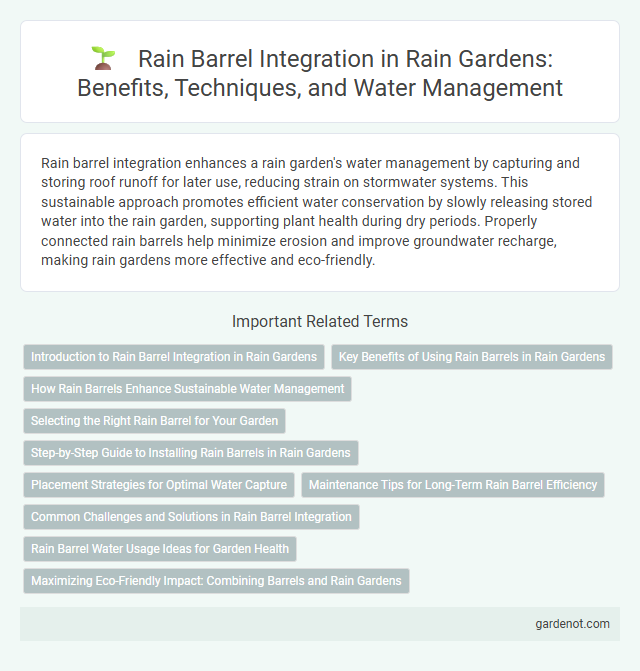Rain barrel integration enhances a rain garden's water management by capturing and storing roof runoff for later use, reducing strain on stormwater systems. This sustainable approach promotes efficient water conservation by slowly releasing stored water into the rain garden, supporting plant health during dry periods. Properly connected rain barrels help minimize erosion and improve groundwater recharge, making rain gardens more effective and eco-friendly.
Introduction to Rain Barrel Integration in Rain Gardens
Rain barrel integration in rain gardens enhances stormwater management by capturing and storing roof runoff for gradual release into the garden, reducing runoff volume and erosion. This system promotes water conservation and supports healthy plant growth by providing a controlled water source during dry periods. Incorporating rain barrels with rain gardens improves urban sustainability by minimizing pollutant load entering local waterways.
Key Benefits of Using Rain Barrels in Rain Gardens
Rain barrels enhance rain gardens by capturing and storing runoff water, reducing stormwater volume and minimizing erosion. They provide a sustainable water source for irrigation, promoting plant health and reducing dependence on municipal water supplies. By controlling water flow, rain barrels help maintain optimal soil moisture, improving the overall efficiency of rain garden ecosystems.
How Rain Barrels Enhance Sustainable Water Management
Rain barrels capture and store rooftop runoff, reducing stormwater volume and easing pressure on municipal drainage systems. By integrating rain barrels with rain gardens, excess water can be directed for controlled infiltration, promoting groundwater recharge and reducing surface pollution. This synergy enhances sustainable water management by maximizing rainwater use and minimizing urban runoff's environmental impact.
Selecting the Right Rain Barrel for Your Garden
Choosing the right rain barrel for your garden involves considering capacity, material, and compatibility with your downspout system. Opt for barrels made from durable, BPA-free plastic or recycled materials to ensure longevity and environmental safety. Select a size that matches your garden's water needs and install features such as overflow spouts and filtration to optimize rainwater collection and prevent debris buildup.
Step-by-Step Guide to Installing Rain Barrels in Rain Gardens
Installing rain barrels in rain gardens begins with selecting a durable barrel positioned near downspouts to maximize water capture. Securely attach the barrel to the downspout, use a screen lid to prevent debris and mosquitoes, and ensure an overflow outlet directs excess water into the rain garden. Connect a spigot near the base for easy water access, and regularly inspect the system to maintain efficient water collection and garden irrigation.
Placement Strategies for Optimal Water Capture
Placing rain barrels at downspouts with unobstructed flow maximizes water capture efficiency by directing runoff directly into the barrel. Positioning barrels on elevated platforms improves gravity-fed water distribution for rain gardens, enhancing irrigation without additional energy. Ensuring barrels are adjacent to permeable soil surfaces facilitates overflow infiltration, reducing stormwater runoff and promoting groundwater recharge.
Maintenance Tips for Long-Term Rain Barrel Efficiency
Regularly inspect rain barrels for debris buildup and clean gutters to prevent clogs that affect water flow. Check and replace seals or spigots annually to maintain airtight conditions and avoid leaks. Use mosquito-proof screens and drain barrels before winter to ensure long-term efficiency and minimize maintenance issues.
Common Challenges and Solutions in Rain Barrel Integration
Integrating rain barrels in rain gardens often faces challenges such as limited water capacity, overflow management, and clogging from debris. Solutions include installing multiple interconnected barrels to increase storage, incorporating overflow valves that direct excess water safely into the garden, and using fine mesh screens to prevent debris from entering the barrel. Proper placement near downspouts ensures efficient water capture and promotes optimal rainwater harvesting for garden irrigation.
Rain Barrel Water Usage Ideas for Garden Health
Rain barrel integration enhances garden health by providing a sustainable source of nutrient-rich water for irrigation, reducing reliance on municipal supplies. Collected rainwater can be used for watering plants, filling birdbaths, and maintaining soil moisture, promoting stronger root systems and improved plant growth. Utilizing rain barrel water minimizes water runoff and conserves resources while supporting a thriving, eco-friendly garden ecosystem.
Maximizing Eco-Friendly Impact: Combining Barrels and Rain Gardens
Integrating rain barrels with rain gardens maximizes water conservation by capturing and storing roof runoff, which can then be slowly released into the garden to reduce stormwater overflow. This combination enhances groundwater recharge and minimizes erosion, promoting a sustainable urban landscape. Utilizing both systems together significantly decreases pollutant load in stormwater, boosting overall eco-friendly impact.
Rain barrel integration Infographic

 gardenot.com
gardenot.com